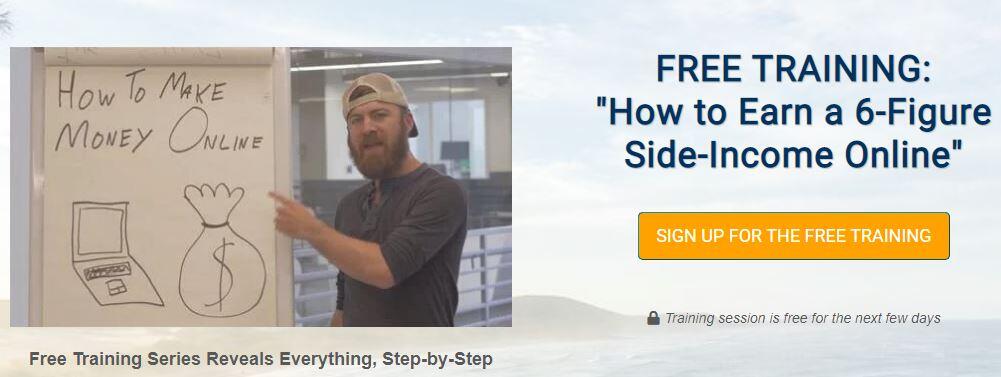
You have probably felt this before.
That knot in your stomach when unexpected expenses occur.
That fear of not having enough money to pay your bills.
Perhaps you’ve seen beautiful tropical travel pictures and felt frustrated you couldn’t afford to take a trip like that.
Whatever your reason, you’re interested in starting a side hustle. Here at JPCashFlow we talk a lot about creating financial independence. It’s our belief that your “9 to 5” probably has some financial limits and that everyone should have a side hustle.
Developing a side hustle can give you that financial breathing room to do more things.
This includes the things you want to do and the things you should be doing!
Investing is one of those things.
Maybe your retirement savings isn’t where it should be. Maybe you don’t have any investments at all. The reason investments matter is because your money grows without you having to work for it. Ultimately, that’s what you really want and that’s how financial independence happens. To make investments you need surplus income to invest.
Enter “The Sidehustle”
There are obviously a lot of ways to sidehustle off-line. You could drive Uber. You could shovel driveways and mow lawns. You could babysit. The list is endless.
Online there are three basic ways you can side hustle. Your online options are: sell products, sell your services, or sell other people’s products and services.
Within each of those categories there are tons of choices and each deserve an article of their own. In this article, we’re going to run through the basics of each major category.
Consider which method appeals to you the most. Then dive into those options. In the comments section below, tell us which you want to hear more about and we’ll do our best to bring you that content.
Sell your Products Online
Selling products online is probably my favorite side hustle. There are many ways to do this. You might choose to sell physical products, digital products, or a hybrid of the two.
Physical products can be sold on marketplaces like Amazon, eBay, Facebook Marketplace, Etsy, and a variety of other sites. You could also start your own website using services like Shopify and build your own brand.
Selling physical products is pretty simple. You can do “arbitrage” which just means buying a product at a retail store (online or offline) and flipping it for a profit. This method can be time consuming and hit or miss. I have met people making six figure full-time incomes doing this, so there is no reason you couldn’t employ this as a successful side hustle.
Other options for selling physical products are wholesale and private label.
Wholesale means that you buy from a distributor and sell the product at a higher price. While similar to arbitrage, the difference is that you are buying at prices lower than retail. You can also re-order those products, which often is not the case when raiding the clearance aisle at your local Target store for arbitrage items.
The barrier to entry in wholesale is that you typically need a business license, employee identification number (similar to a social security number, but issued to businesses), and there are likely minimum order quantities. You are also likely to encounter lots of competition in this space and be limited by minimum advertised price (MAP) rules.
Private label is probably the most advanced method for selling physical products. In private label, you are building your own brand. Assuming you can’t physically make this product yourself, you buy it from a manufacturer and put your own packaging on it. This is the most lucrative route in physical product selling.
Private label requires a lot more work and capital than wholesale or arbitrage opportunities. For starters, if you’re selling on Amazon, you’ll have to build your own listing. You’ll need to get appropriate photos, get reviews, and run paid advertising to drive traffic to the new listing. Private label typically requires a good amount of working capital to source your new product. Manufacturers will often have minimum order quantities (referred to as MOQ) that you will have to meet to place an order.
People will often work with factories overseas (primarily China) to source their goods. This creates a whole other set of logistical challenges, from talking with foreign reps and taking shipment of the order. You will have to learn how to negotiate with manufacturers and deal with trans-pacific freight forwarding.
While private label might sound intimidating, it is definitely something you can learn. Before trying it, I’d encourage you to try arbitrage or even just selling things from around your house first. This will teach you the basics of whatever selling platform you decide to try.
Digital products offer an advantage over physical products in that you don’t have to carry inventory. Everyone has expertise in something. Think about what areas you know about. Preferably it’s a topic you’re passionate about too. One of those things might make for a great digital product.
You don’t have to be a great writer to create a digital product. If you are, then blogging and e-books are a good place to start. If you’re not, then maybe you would be better off making video content about your topic of choice.
For written products, Amazon’s KDP program allows you to self-publish Kindle e-books and physical paperbacks that will be printed on demand when someone orders them. For video content, you might try creating a course on a site like Udemy. Udemy offers classes on all sorts of topics. Check out their site and take a look at what courses other people are creating.
Earlier I mentioned “hybrid” physical products. This is what I focus most of my business on these days. What I’m referring to is “print-on-demand products” (POD for short). You have probably seen ads on Facebook for t-shirts that relate to your interests. Those shirts don’t exist until you order them in most cases. An order comes in and a manufacturer will print graphics on the shirt before sending it to the customer.
This isn’t limited to t-shirts. There are print-on-demand services for all types of products. You can do this with everything from clothing, to glassware, to art someone might hang on their wall. The possibilities are endless. Two services I use for this are Merch by Amazon and Printful.
The main advantage of this hybrid model is that you don’t have to manage physical inventory. Another advantage is that your overhead costs are usually lower. You can put new products on the internet every single day. You’re only limited by your creativity.
Sell your Services Online
Another option for side hustling online is selling services. No matter what your skills are, you probably could offer something of value to people. Similar to digital products, you have to think about what you’re knowledgeable about and good at.
Some of the things people do as services are making videos, taking pictures, proofreading, making graphics, and an endless list of other tasks. Two service websites you can check out are Fiverr and Upwork.
The advantage of doing services instead of products is that there is pretty much no overhead. The disadvantage is that you’re trading time for money.
If this model appeals to you, check out the previously mentioned sites and look at the services other people are offering. Check out the prices they are quoting. Think about what services you can offer and what you would charge.
While those sites are good places to get started, ultimately you would be best served to create a “personal service brand”. Market yourself on social media. Create your own website. Network with people who could use your help. Until you get to that point, use something like Fiverr to building your confidence and make your first sale online.
Sell Other People’s Products & Services
Last on our list of business models is selling other people’s products or services. This is usually referred to as “affiliate marketing”.
Ever been on a site where they gave you a referral code to invite friends? Maybe they offered you free rides like Uber does or cold hard cash like the shopping portal EBates. Those are examples of affiliate marketing.
The best way to start affiliate marketing is to look at the products and services that you use. What would you recommend to your closest friends and family? See if they have a referral program. At the bottom many websites they’ll have a link that says “Affiliate” if they offer such a program.
Marketing your affiliate offers can start with your personal network. It helps if you have a big social media following. Outside of your personal network, people use blogs and paid traffic to get prospects to their affiliate offers.
The advantage of affiliate marketing is that you don’t have to build a product of your own and you don’t have to trade time for money. The disadvantages are that it can be very competitive and getting people to “convert” (follow through on your offer) can be tough. If you use paid traffic, you might lose money trying to market your affiliate offer.
Final Thoughts
Don’t let the disadvantages mentioned on any of these business models stop you from exploring them. There are people that makes hundreds, thousands, and sometimes millions doing pretty much all of these business models. If your goal is a side hustle, then it’s likely a few hundred bucks extra a month would make you happy. That can be done with ANY of the ideas we gave you today.
If you want to start making money online, check out the free training below. Thanks for reading.

Leave a Reply